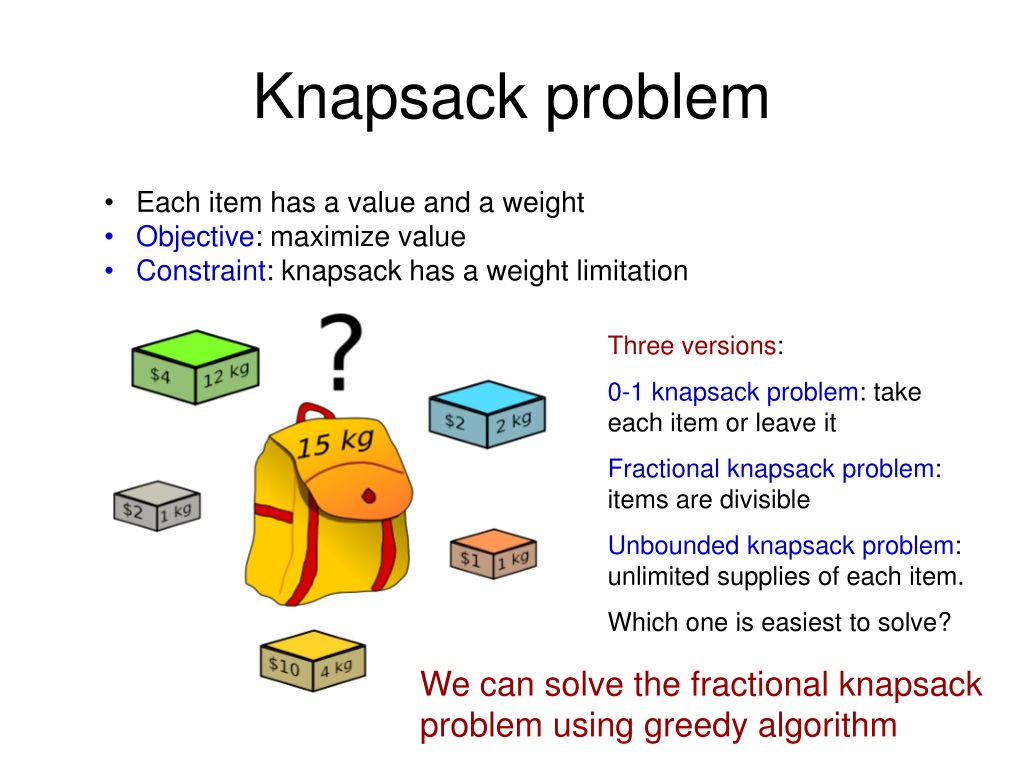
A hybrid algorithm for the 0–1 knapsack problem. (1999): Core problems knapsack algorithms. Solving permutation problems with continuous EDAs. Penalty functions and the knapsack problem. Knapsack Problems: Algorithms and Computer Implementations. A new algorithm for the 0–1 knapsack problem. A reduction algorithm for zero-one single knapsack problems. Mapping, order-independent genes and the knapsack problem. Technical report, Department of Computer Science. A note on the performance of genetic algorithms on zero-one knapsack problem. Gordon, W.S., Bohm, A.P.W., and Whitney, D. A Guide to the Theory of NP-completeness.

An algorithm for the solution of the 0–1 knapsack problem. Methods of Operational Research, 36:49–60.įayard, D.

A reduction algorithm for knapsack problems. Journal of Heuristics, 4:63–86.ĭembo, R.S. A genetic algorithm for the multidimensional knapsack problem. Fourteenth European Conference on Artificial Intelligence, ECAI2000.Ĭhu, P.C. In Workshop Notes of CaNew2000: Workshop on Bayesian and Causal Networks: From Inference to Data Mining. An empirical comparison between different approaches with synthetic data. Inexact graph matching using learning and simulation of Bayesian networks. In AAAI-98.īengoetxea, E., Larrañaga, P., Bloch, I., Perchant, A., and Boeres, C. Fast probabilistic modeling for combinatorial optimization. Technical report, School of Computer Science. An empirical comparison of seven iterative and evolutionary function optimization heuristics. An algorithm for large zero-one knapsack problems. Your dp = 10 will get returned, which is incorrect because a different weight might lead to a different possible value.Balas, E. Let's say your recursively reach i=5 again, but with a different weight this time. Let's say your dp table has a value dp = 10, which was calculated for a weight of x. So it requires only 2 properties (house value and index), it is done using 1D DP.Ī small note on why your 1D approach is incorrect: You just have to avoid picking consecutive houses (which can be done using indexes, no additional property needed). In the House Robbers problem, you're maximizing the value without having to keep a check on the count/weight of houses robbed. Since you're maintaining three properties in the DP state (index, weight, value of each item) you use 2D DP. There's no restriction on the item ordering that you select (basically, no constraint like "you can't select three consecutive items" or so).

In 0/1 Knapsack problem, you have to maximize the value and keep the total weight under a given limit. They are too big to post here.įrom what I understand, this assumption is incorrect. weights =, values =, n = 3, sackweight = 4.# recursive call after excluding the element at the currentIndexĭp, profits, weights, capacity, currentIndex + 1)ĭp = max(profit1, profit2) Profit1 = profits + knapsack_recursive(ĭp, profits, weights, capacity - weights, currentIndex + 1) # if the weight of the element at currentIndex exceeds the capacity, we # recursive call after choosing the element at the currentIndex # if we have already solved a similar problem, return the result from memory Return knapsack_recursive(dp, profits, weights, capacity, 0)ĭef knapsack_recursive(dp, profits, weights, capacity, currentIndex): The given answer using 2-D array below def solve_knapsack(profits, weights, capacity):ĭp = for y in range(len(profits))] Res = dp = max(values + recur(i+1, weightleft - weights), recur(i+1, weightleft)) # my approach using a 1-D array to memoize def knapSack(self,sackw, weights, values, n):

The solution had a 2-D array which is confusing me that why is there a need for 2-D array to store the remaining/occupied weight, as during recursion we are already passing the remaining/occupied weight.
0 1 knapsack problem code#
But I tried to code it up in similar way using 1-D array but it gave wrong answers. I understood the House Robbers problem nicely and found 0/1 Knapsack similar to it. I'm asking this in reference to Dynamic Programming, I'm a beginner at it.


 0 kommentar(er)
0 kommentar(er)
